六年级英语上册(湘教版)
- 格式:ppt
- 大小:943.50 KB
- 文档页数:10
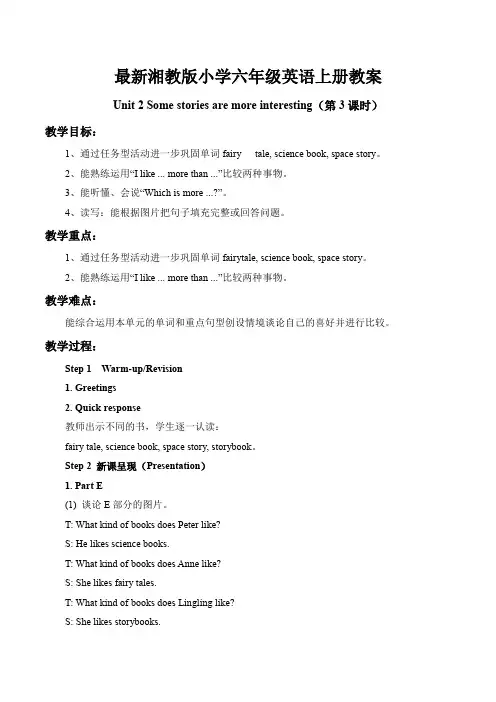
最新湘教版小学六年级英语上册教案Unit 2 Some stories are more interesting(第3课时)教学目标:1、通过任务型活动进一步巩固单词fairy tale, science book, space story。
2、能熟练运用“I like ... more than ...”比较两种事物。
3、能听懂、会说“Which is more ...?”。
4、读写:能根据图片把句子填充完整或回答问题。
教学重点:1、通过任务型活动进一步巩固单词fairytale, science book, space story。
2、能熟练运用“I like ... more than ...”比较两种事物。
教学难点:能综合运用本单元的单词和重点句型创设情境谈论自己的喜好并进行比较。
教学过程:Step 1 Warm-up/Revision1. Greetings2. Quick response教师出示不同的书,学生逐一认读:fairy tale, science book, space story, storybook。
Step 2 新课呈现(Presentation)1. Part E(1) 谈论E部分的图片。
T: What kind of books does Peter like?S: He likes science books.T: What kind of books does Anne like?S: She likes fairy tales.T: What kind of books does Lingling like?S: She likes storybooks.T: How about Mingming?S: He likes science books and fairy tales.教师在学生简短回答后,给予完整的回答,然后E部分的句子,让学生感知句型的读音和意义。
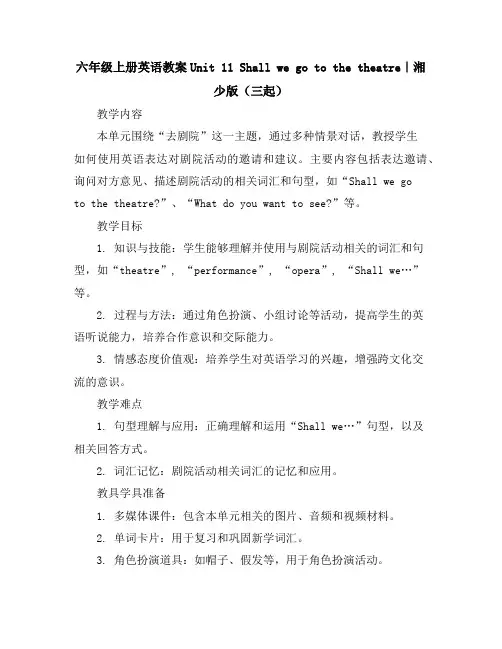
六年级上册英语教案Unit 11 Shall we go to the theatre|湘少版(三起)教学内容本单元围绕“去剧院”这一主题,通过多种情景对话,教授学生如何使用英语表达对剧院活动的邀请和建议。
主要内容包括表达邀请、询问对方意见、描述剧院活动的相关词汇和句型,如“Shall we goto the theatre?”、“What do you want to see?”等。
教学目标1. 知识与技能:学生能够理解并使用与剧院活动相关的词汇和句型,如“theatre”, “performance”, “opera”, “Shall we…”等。
2. 过程与方法:通过角色扮演、小组讨论等活动,提高学生的英语听说能力,培养合作意识和交际能力。
3. 情感态度价值观:培养学生对英语学习的兴趣,增强跨文化交流的意识。
教学难点1. 句型理解与应用:正确理解和运用“Shall we…”句型,以及相关回答方式。
2. 词汇记忆:剧院活动相关词汇的记忆和应用。
教具学具准备1. 多媒体课件:包含本单元相关的图片、音频和视频材料。
2. 单词卡片:用于复习和巩固新学词汇。
3. 角色扮演道具:如帽子、假发等,用于角色扮演活动。
教学过程1. 课堂导入:通过播放剧院活动的相关视频,吸引学生注意力,引入主题。
2. 新知呈现:利用多媒体课件,展示并教授新词汇和句型。
3. 实践操练:通过角色扮演、小组对话等形式,让学生在实际语境中运用所学知识。
4. 巩固提高:通过游戏、竞赛等活动,巩固学生对新知识的理解和记忆。
板书设计1. 中心词:以“theatre”为中心,辐射出相关词汇。
2. 句型展示:用不同颜色标注“Shall we…”句型及其回答方式。
3. 活动流程:简明扼要地展示教学活动的步骤和内容。
作业设计1. 书面作业:完成教材中的相关练习题。
2. 口头作业:与家长或同伴进行关于剧院活动的对话练习。
3. 扩展作业:查找并介绍一种自己喜欢的剧院活动,下节课分享。
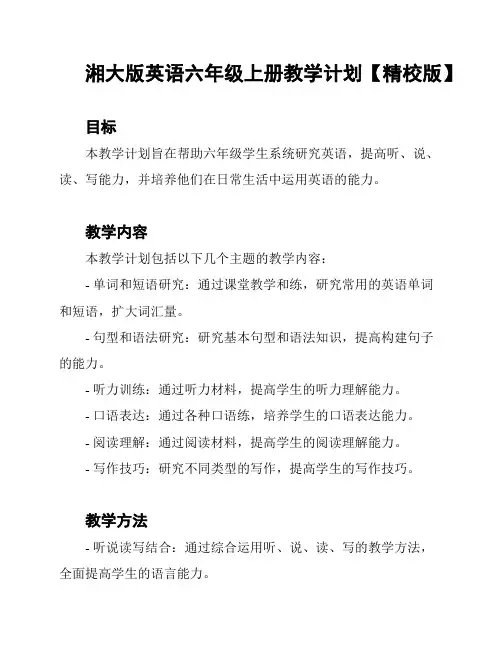
湘大版英语六年级上册教学计划【精校版】
目标
本教学计划旨在帮助六年级学生系统研究英语,提高听、说、读、写能力,并培养他们在日常生活中运用英语的能力。
教学内容
本教学计划包括以下几个主题的教学内容:
- 单词和短语研究:通过课堂教学和练,研究常用的英语单词
和短语,扩大词汇量。
- 句型和语法研究:研究基本句型和语法知识,提高构建句子
的能力。
- 听力训练:通过听力材料,提高学生的听力理解能力。
- 口语表达:通过各种口语练,培养学生的口语表达能力。
- 阅读理解:通过阅读材料,提高学生的阅读理解能力。
- 写作技巧:研究不同类型的写作,提高学生的写作技巧。
教学方法
- 听说读写结合:通过综合运用听、说、读、写的教学方法,
全面提高学生的语言能力。
- 互动教学:鼓励学生参与课堂活动,培养学生的研究兴趣和积极性。
- 情景教学:通过情景模拟和角色扮演,让学生在实际情境中运用所学知识。
教学进度安排
教学评估
本教学计划将根据学生的听、说、读、写能力进行综合评估。
教师将通过课堂表现、考试和作业等方式进行评估,并及时给予学
生反馈和指导。
参考资料
- 《湘大版英语六年级上册教材》
- 电子课件和多媒体教具
- 听力材料和阅读材料
以上是《湘大版英语六年级上册教学计划【精校版】》的内容。
希望能够为学生提供良好的英语学习环境,促进他们英语能力的全
面发展。

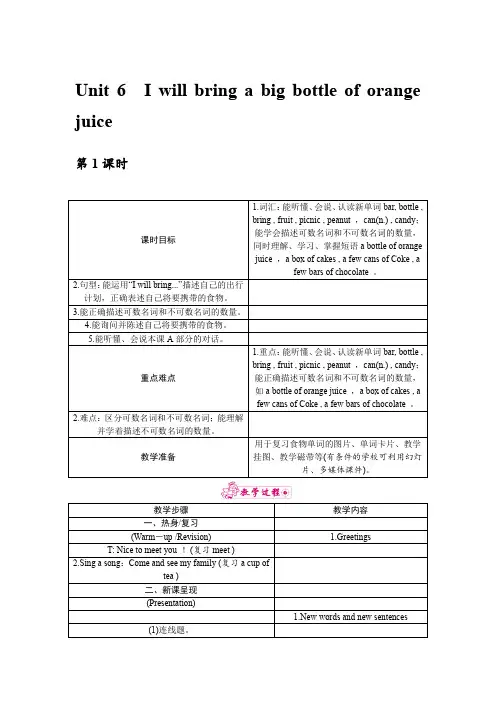
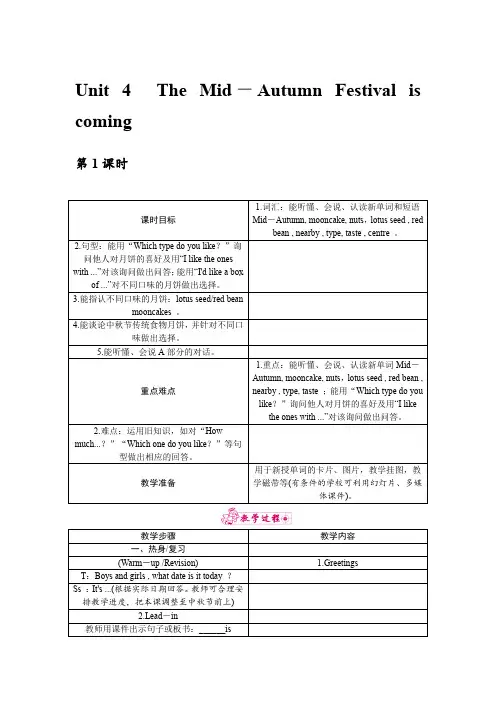
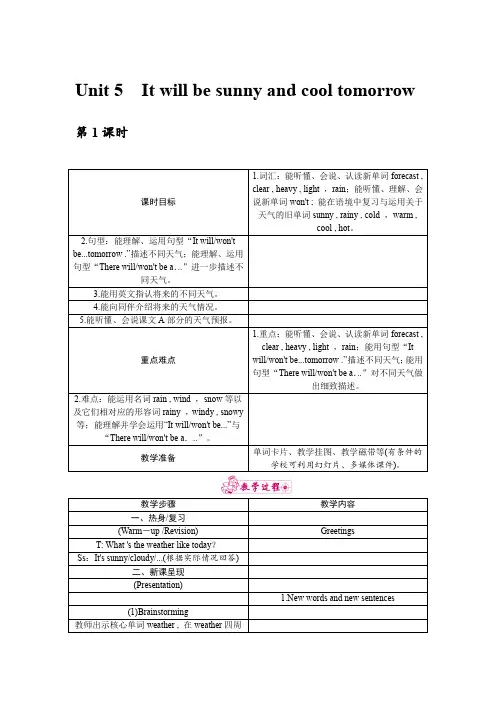
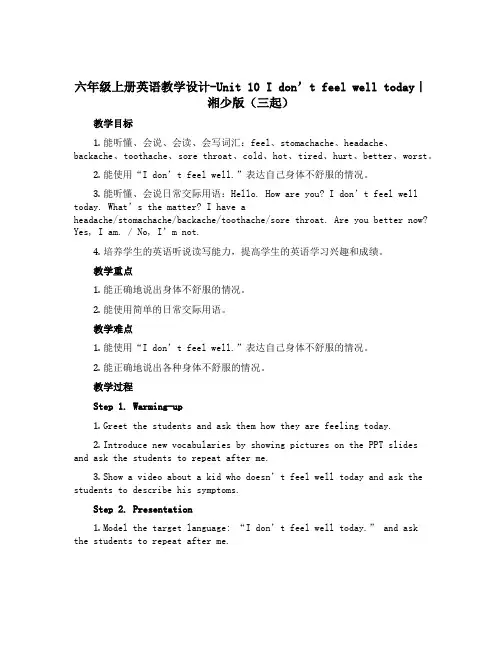
六年级上册英语教学设计-Unit 10 I don’t feel well today|湘少版(三起)教学目标1.能听懂、会说、会读、会写词汇:feel、stomachache、headache、backache、toothache、sore throat、cold、hot、tired、hurt、better、worst。
2.能使用“I don’t feel well.”表达自己身体不舒服的情况。
3.能听懂、会说日常交际用语:Hello. How are you? I don’t feel well today. What’s the matter? I have aheadache/stomachache/backache/toothache/sore throat. Are you better now? Yes, I am. / No, I’m not.4.培养学生的英语听说读写能力,提高学生的英语学习兴趣和成绩。
教学重点1.能正确地说出身体不舒服的情况。
2.能使用简单的日常交际用语。
教学难点1.能使用“I don’t feel well.”表达自己身体不舒服的情况。
2.能正确地说出各种身体不舒服的情况。
教学过程Step 1. Warming-up1.Greet the students and ask them how they are feeling today.2.Introduce new vocabularies by showing pictures on the PPT slides and ask the students to repeat after me.3.Show a video about a kid who doesn’t feel well today and ask th e students to describe his symptoms.Step 2. Presentation1.Model the target language: “I don’t feel well today.” and ask the students to repeat after me.2.Introduce different phrases for different symptoms: “I have a stomachache/headache/backache/toothache/sore throat/cold.” and ask the students to repeat after me.3.Drill the new vocabularies in a chorus and individually.Step 3. Practice1.Ask the students to work in pairs and use the target language to talk about their symptoms.2.Invite some pairs to do a role-play in front of the class.3.Give feedback and correction if necessary.Step 4. Production1.Ask the students to make a short dialogue with a partner by using the target language and present it in front of the class.Step 5. Consolidation1.Review the new vocabularies and target language by playing a game.2.Quiz the students on the symptoms by showing a picture and asking them to say the correct word.Step 6. Homework1.Finish Exercise 1 and 2 on Page 44 in the textbook.2.Write a short paragraph about how they are feeling today by using the target language.教学评价1.观察学生是否正确地说出身体不舒服的情况和日常交际用语。
